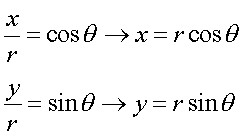
Question 2
– Where does this equations come from?
![]()
The approach I am going to make is from an underlying
assumption.
Look around you or read a trig book lying beside you
– sine and cosine rule
the world. These
two proportions allow us to work with vectors with ease.
First let us consider a vector with length “r” at an
angle to the x-axis of ![]() .
.

Its two components will look like this

And thereby forming this triangle

![]()
In terms of vector addiction the vector “r” is the
sum of the vector “x” and the vector “y”
![]()
Now, we can define the particular vectors.
The x vector is equal to x times the x direction or
the “i” vector and
the y vector is equal to y times the y direction or
the “j” vector.
![]()

Using basic trigonometry we can discover in even more
detail what the x and y vectors actually equal.

So now we know:

And therefore by direct substitution into the original
start of ![]() we obtain
we obtain
![]()
Now we come to the final step. In uniform circular motion the angular
velocity is equal to
the change in the angle of the change in time (where
omega equals angular velocity in units of radians per second)

By separating the variables and taking the integral
we find that theta equals omega times time.
![]()
![]()
And thus we finally have our last equation:
![]()
Here are some helpful Math Links:
www.hotmath.org (works problems from specific books)
www.calc101.com (just helpful)
www.sosmath.com (gives some nice proofs)
http://www.sparknotes.com/physics/.dir/ (good with the basics)
http://www.ncsu.edu/felder-public/kenny/home.html
http://www.lib.duke.edu/mathphy/index.htm